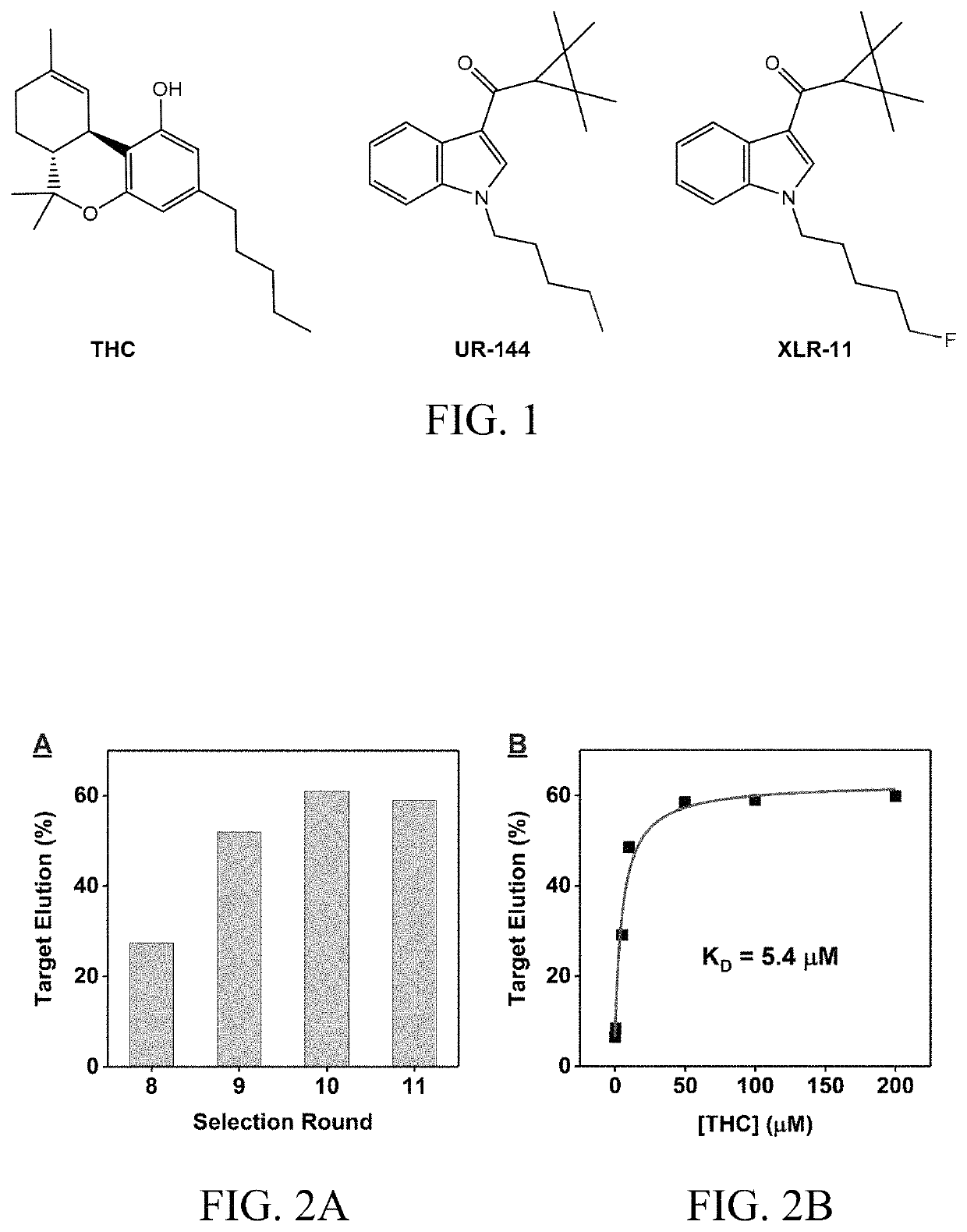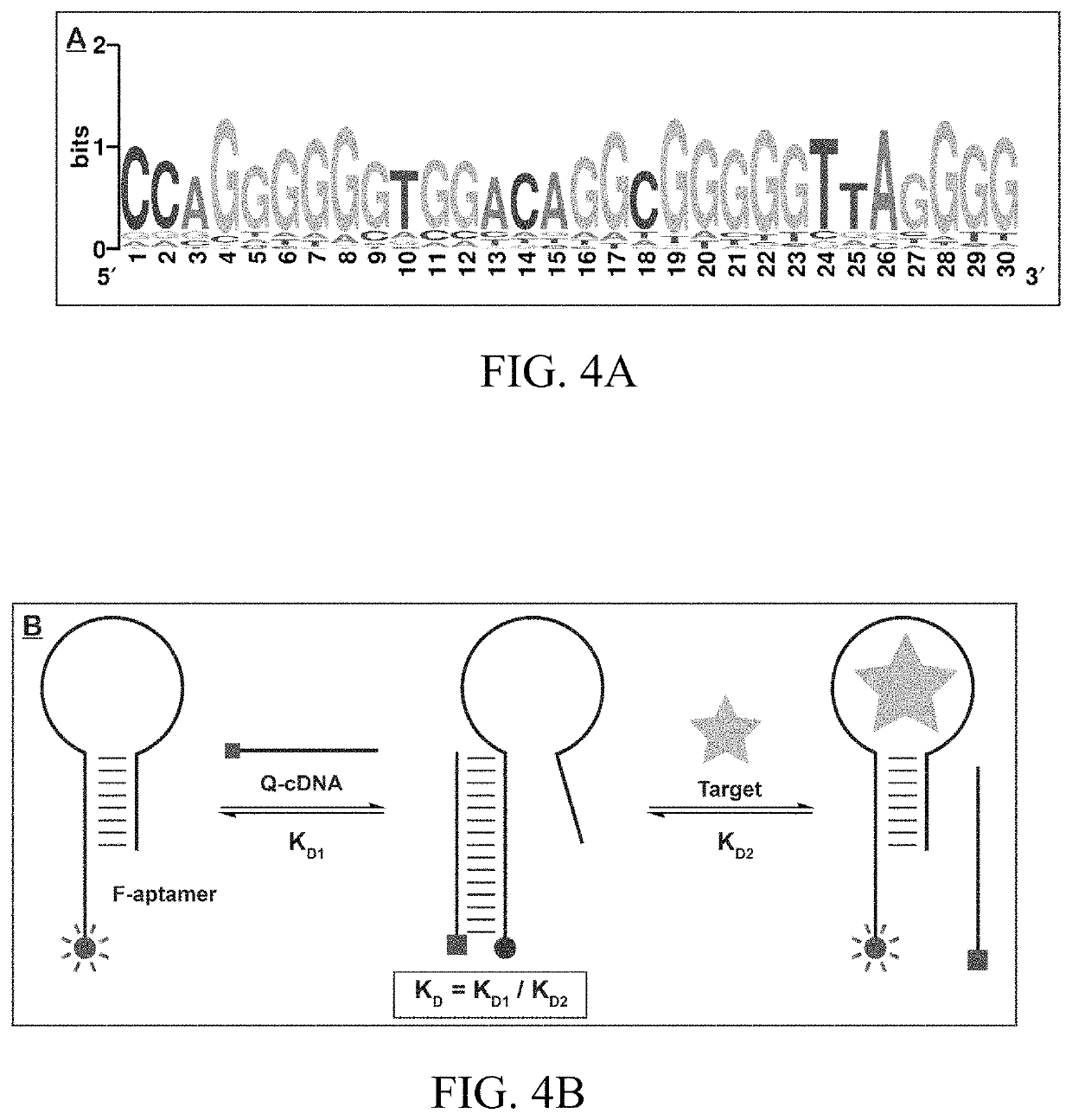Aptamers that bind to natural and synthetic cannabinoids
a technology of aptamers and cannabinoids, applied in the field of aptamers that bind to natural and synthetic cannabinoids, can solve the problems of inability to precisely control the affinity and specificity of the resulting antibodies, the size of the target as well as its structure and physicochemical properties, and the difficulty in isolating high-affinity oligonucleotide aptamers to small molecules, etc., to achieve the effect of improving
- Summary
- Abstract
- Description
- Claims
- Application Information
AI Technical Summary
Benefits of technology
Problems solved by technology
Method used
Image
Examples
example 1
[0150]Numerous aptamers have been isolated for various small molecules. However, it has been challenging to isolate aptamers for small molecules with a limited number of epitopes or low water-solubility. The limitations of natural DNA libraries were explored by isolating aptamers in vitro against three low-epitope hydrophobic small molecule targets: (−)-trans-Δ9-tetrahydrocannabinol (THC), UR-144 and XLR-11 (FIG. 1) via SELEX.
[0151]To investigate whether there are limitations in isolating aptamers with high affinity and specificity for challenging hydrophobic targets such as THC from unmodified DNA libraries, and to determine the extent of the influence that the selection conditions have on the outcome of SELEX, previously reported stem-loop structured library containing 30 random nucleotides in combination with the library-immobilized SELEX method was used for aptamer isolation. This selection procedure has successfully yielded aptamers targeting various s...
example 2
ization of the Isolated THC-Binding Aptamer
[0158]THC1.2 was then synthesized and a fluorescence assay and isothermal titration calorimetry (ITC) were used to characterize the target-binding affinity of the aptamer. Both methods are well established for measuring aptamer affinity for small molecules with KD of 10 nM-1 mM.
[0159]The high target-binding affinity of THC1.2 was first confirmed using a strand-displacement fluorescence method. The calculation of the binding affinity of target to the aptamer requires determining the affinity of the aptamer to a complementary DNA strand (KD1) and the affinity of the target towards the aptamer-cDNA complex (KD2). Specifically, the Cy5-labeled aptamer (F-THC1.2) and an IowaBlack RQ-labeled complementary DNA strand (Q-cDNA) were synthesized. When the aptamer is free in solution, the fluorophore emits strong fluorescence. However, when the aptamer hybridizes with its Q-cDNA, the quencher is brought into close proximity to the fluorophore, and flu...
example 3
of a DNA Aptamer that Binds to Both UR-144 and XLR-11
[0164]To further probe the limits of unmodified libraries, an aptamer binding to UR-144 and XLR-11, two widely-abused synthetic cannabinoids with high structural similarity were isolated. In terms of functional groups available for aptamer binding, these targets contain only an indole ring, a ketone, pentyl tail, and tetramethylcyclopropyl ring. No aptamer has been isolated for these targets, or any small molecule with so few functional groups with an unmodified library.
[0165]The same library-immobilized SELEX procedure, the library described above and the previously-reported parallel-and-serial selection strategy were used to isolate an aptamer capable of binding both UR-144 and XLR11. Overall, it took three different approaches before an aptamer could be isolated binding to UR-144 and XLR-11 with high affinity and specificity.
[0166]The road map of SELEX is shown in FIG. 10. First, in parallel selection, SELEX is performed with e...
PUM
| Property | Measurement | Unit |
|---|---|---|
| dissociation constant | aaaaa | aaaaa |
| dissociation constant | aaaaa | aaaaa |
| dissociation constant | aaaaa | aaaaa |
Abstract
Description
Claims
Application Information
 Login to View More
Login to View More - R&D
- Intellectual Property
- Life Sciences
- Materials
- Tech Scout
- Unparalleled Data Quality
- Higher Quality Content
- 60% Fewer Hallucinations
Browse by: Latest US Patents, China's latest patents, Technical Efficacy Thesaurus, Application Domain, Technology Topic, Popular Technical Reports.
© 2025 PatSnap. All rights reserved.Legal|Privacy policy|Modern Slavery Act Transparency Statement|Sitemap|About US| Contact US: help@patsnap.com



